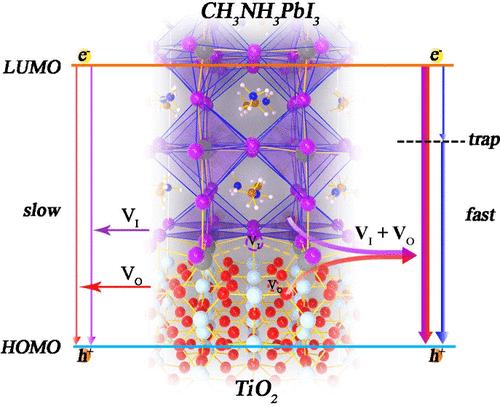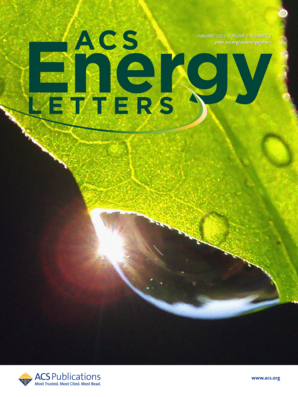TiO2/CH3NH3PbI3 界面的有害缺陷合作性:稳定性降低、离子扩散增强、电荷寿命和传输缩短
IF 18.2
1区 材料科学
Q1 CHEMISTRY, PHYSICAL
引用次数: 0
摘要
界面对太阳能电池的性能至关重要,因为它们控制着电荷分离和传输。我们利用量子动力学模拟证明,在界面上,CH3NH3PbI3(VI)中的碘空位和 TiO2(VO)中的氧空位这两种本身无害的常见缺陷是造成稳定性差和电荷损失的协同原因。VO 会促进 VI 的扩散并加速碘的迁移。中隙陷阱状态的出现,抑制了电荷传输,并将电荷重组的速度加快了一个数量级。强烈的结构畸变加强了电子-振动相互作用,并激活了高频二氧化钛声子。由于人们广泛报道了铅卤化物包晶的高缺陷耐受性,包晶缺陷与其他材料缺陷的协同有害影响往往被忽视。界面缺陷配对可能是包晶体太阳能电池稳定性差和电荷损失的主要原因。研究结果表明,要实现高性能,高质量的过氧化物或高质量的电荷萃取层可能就足够了。本文章由计算机程序翻译,如有差异,请以英文原文为准。

Detrimental Defect Cooperativity at TiO2/CH3NH3PbI3 Interface: Decreased Stability, Enhanced Ion Diffusion, and Reduced Charge Lifetime and Transport
Interfaces are essential for solar cell performance since they govern charge separation and transport. Using quantum dynamics simulation, we demonstrate that at interfaces, common defects that are benign on their own, iodine vacancy in CH3NH3PbI3 (VI) and oxygen vacancy in TiO2 (VO), are responsible synergistically for poor stability and charge losses. VO promotes VI diffusion and accelerates iodine migration. A midgap trap state appears, inhibiting charge transport and accelerating charge recombination by an order of magnitude. Strong structural distortions strengthen electron-vibrational interactions and activate high-frequency TiO2 phonons. Because of the widely reported high defect-tolerance of lead-halide perovskites, the synergistic detrimental influence of perovskite defects with defects in other materials is often overlooked. The interfacial defect pairing could be a major reason for poor stability and charge losses in perovskite solar cells. The results suggest that either a high-quality perovskite or high-quality charge extraction layer may be sufficient to achieve high performance.
求助全文
通过发布文献求助,成功后即可免费获取论文全文。
去求助
来源期刊

ACS Energy Letters
Energy-Renewable Energy, Sustainability and the Environment
CiteScore
31.20
自引率
5.00%
发文量
469
审稿时长
1 months
期刊介绍:
ACS Energy Letters is a monthly journal that publishes papers reporting new scientific advances in energy research. The journal focuses on topics that are of interest to scientists working in the fundamental and applied sciences. Rapid publication is a central criterion for acceptance, and the journal is known for its quick publication times, with an average of 4-6 weeks from submission to web publication in As Soon As Publishable format.
ACS Energy Letters is ranked as the number one journal in the Web of Science Electrochemistry category. It also ranks within the top 10 journals for Physical Chemistry, Energy & Fuels, and Nanoscience & Nanotechnology.
The journal offers several types of articles, including Letters, Energy Express, Perspectives, Reviews, Editorials, Viewpoints and Energy Focus. Additionally, authors have the option to submit videos that summarize or support the information presented in a Perspective or Review article, which can be highlighted on the journal's website. ACS Energy Letters is abstracted and indexed in Chemical Abstracts Service/SciFinder, EBSCO-summon, PubMed, Web of Science, Scopus and Portico.
 求助内容:
求助内容: 应助结果提醒方式:
应助结果提醒方式:


